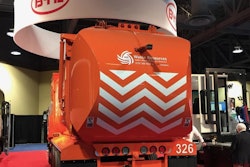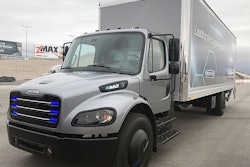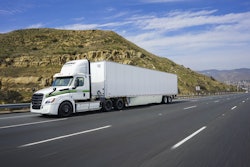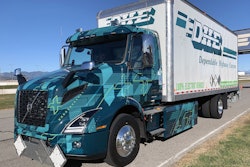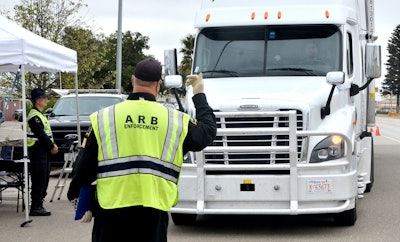
Keeping score is important, and that’s especially true in the world of emissions where microscopic elements can force billion dollar changes in the trucking industry.
For those keeping score on emissions, it’s no secret that California has been leading and winning the fight for years. Before the phrase “climate change” became en vogue, the state had passed the Global Warming Solutions Act of 2006, otherwise known as Assembly Bill 32 (AB 32).
AB 32 serves as an important legislative guide for the state. The California Air Resources Board (CARB) refers to the directive on their website:
In response to AB 32, California is implementing measures to achieve emission reductions of greenhouse gases (GHG) that cause climate change. Climate change programs in California are effectively reducing GHG emissions that come from all sectors of the economy. These programs include regulations, market programs, and incentives that will transform the areas of transportation, industry, fuels, and others, to take California into a sustainable, low-carbon and cleaner future, while maintaining a robust economy.
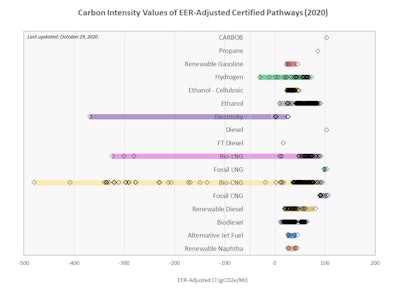 Bio CNG, or renewable natural gas, is an internal combustion fuel that has the lowest carbon intensity value of competing alt fuels including electric according to the California Air Resources Board. (Source: CARB.)
Bio CNG, or renewable natural gas, is an internal combustion fuel that has the lowest carbon intensity value of competing alt fuels including electric according to the California Air Resources Board. (Source: CARB.)Keeping the climate from changing, or at least attempting to stop the forces that change the climate, is no easy task. To that end, the state created the Low Carbon Fuel Standard program. On the fleet level, the state offers plenty of information on low carbon fuel alternatives and dangles incentives to drive fleets towards those fuels. Incentives play a huge role. NFI Industries, which is currently running 10 electric Freightliner eCascadias in Southern California, recently told me that if not for the Golden State’s incentives, mass adoption of electric trucks would not be possible.
But in the fight to lower greenhouse gases, there are other alternatives available to fleets. To that end — and as a required by the LCFS program — CARB publishes carbon intensity values for several alternative fuels. Of particular note is bio-CNG, otherwise known as renewable natural gas, which in a chart updated on Oct. 29 CARB scored at roughly -475. Yes, that’s minus 475 – an extremely low number that clearly outscores all other fuels. Electric comes in second with a carbon intensity value at around -365. These scores fluctuate depending on various factors, namely fuel sources.
So how are negative carbon scores possible? Renewable natural gas is produced from methane, which both the U.S. Environmental Protection Agency and CARB consider 21 times more destructive to the ozone layer than carbon dioxide. By capturing methane from a variety of sources like wastewater, landfills and dairies, and rendering it into fuel, the gas is not released into the atmosphere where scientists say it can hasten climate change.
It’s no secret that stories abound over concerns of methane. Some headlines are tough to ignore, like one published by NBC News in July which reads, “Soaring methane emissions threaten to put climate change goals out of reach.” If not kept in check, the article warns that methane could “contribute to more than 2 degrees Celsius of global warming by 2100.”
You would think that given the well-publicized danger methane poses that California would be more vocal in its support of renewable natural gas. After all, the state keeps blaming deadly fires there on climate change. Regardless, RNG hasn’t received nearly as much press compared to electric. A search today on CARB’s website rendered 259 results for electric versus only 35 for renewable natural gas. Need more proof?
“California is an innovation juggernaut that is going electric,” said Jared Blumenfeld, California’s Secretary for Environmental Protection. “We are showing the world that we can move goods, grow our economy and finally dump dirty diesel.”
Okay, we’ve all heard the phrase dirty diesel. But what about dirty natural gas? China-based BYD, the world’s largest electric vehicle manufacturer, which former California governor Jerry Brown wooed into the state where they set up a truck and bus factory in Lancaster, recently called natural gas a dirty fuel. A dirty fuel? Really? This is the same company that acknowledged the inefficiencies of battery recycling and the highly toxic waste it produces. Since when is toxic waste not so dirty? Wow. Good luck with those battery impact fees. At least lead-acid can be completely recycled.
Blumenfeld endorsed electric after CARB announced this summer what it called the first rule of its kind in the world: Starting in 2024, OEMs must begin transitioning to zero emission commercial truck and van sales in California. By 2045, all new trucks and vans sold there have to be zero emission.
Though Blumenfeld didn’t specifically mention hydrogen fuel cells — the only other developing technology that can currently meet zero emission targets — let’s assume that he had them in mind since, after all, fuel cell vehicles are essentially electric powertrains that, instead of leaning wholly on an onboard battery, are supplied electric current through an electrochemical process that takes place in a fuel cell.
Interestingly enough, hydrogen can be obtained from renewable natural gas. Shell has been producing hydrogen from biogas which Kenworth has been using in its T880 fuel cell trucks in Southern California.
Renewable natural gas used in internal combustion engines has been certified at near-zero emissions, not zero, which CARB has mandated. However, it’s worth noting that electric is only as clean as its power source. In California, more alternative forms of electricity production are becoming available, like solar, windmills and renewable natural gas. Electric’s low carbon intensity value of -365 is possible thanks to power plants that use renewable natural gas.
So if an electric truck is being charged by a power plant that’s running on renewable natural gas, that could bode well for all concerned. The problem is the current inefficiency of all-electric Class 8 trucks.
“I can get three trips to the port in a diesel in a day,” O’Leary said when describing the performance of his eCascadias. “I can only get two with the electric because it needs to charge.”
So in that case renewable natural gas comes out even further ahead — sort of. RNG is in short supply but that could be changing according to Anil Prabhu, CARB’s manager of fuels evaluation.
“Right now the dairy biogas with the large negative scores is not a big part of the market yet because we only have 10 or 12 [RNG] projects,” Prabhu said. “But when you get down to the 100-plus that the California Department of Food and Ag has actually incentivized, we may end up saturating that market. I’m not saying we don’t want to incentivize bio CNG, but we also have to look at it as ARB is not paying a fleet operator to buy a bio CNG truck. A fleet operator makes that decision.”
Conversely, important decision-making also rests with CARB, which by choosing to phase out internal combustion engines really calls into question the veracity of carbon intensity scores and the state’s goal of fighting climate change. CARB’s own math shows an internal combustion fuel outpacing electric in terms of carbon intensity, yet the state, as Blumenfeld said, “is going electric.” That may be the case, but in doing so, it looks like a lot of stakeholders are going to be paying one heck of a price.



